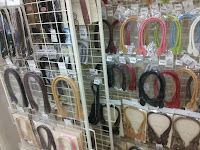Specific shops are kind of hard to find in Japan.. Most stores are kind of like variety shops, plus everything is crowded and hidden in tall/narrow buildings, and none of the Japanese people I know could think of a craft-specific store. I did end up finding a couple of craft places on Google maps, but in the end, the two big places I went to were places that I happened upon from pure luck and exploration.
The first place I went to.. Well, the name escapes me.. But it took up a large portion of the basement in the Kyoto Tower. We discovered this by roaming around the shops in the Kyoto station and wandering down a hallway that had a downstairs (because we were starving and a sign said there were restaurants, which we didn't find).. It wasn't until later that we put together the fact that we were a) in the Kyoto tower basement, and b) that it was connected to the station, which was huuuge..
The pink shows the underground parts of Kyoto station.. A/B is the location of the tower.
It's a lie! This station is even bigger!!
It's a lie! This station is even bigger!!
The second place I went to was in Nagoya. This one was called Craft Heart Tokai. Also discovered "by accident," in a hallway of girly shops next to Kanayama station. I ended up going here every day while I was in Nagoya, just to marvel over the things and how much I wish I could have bought. It's amazing how fast they change out the products on a day-to-day basis in Japan!
My fave craft store is here. :]
So now that I've overloaded you with text, I'll show you some pictures from inside that second store that I visited four days in a row. Consider these to be reasons why you should go to a Japanese craft store!
One of the decoden aisles.. Tiny fake sweets, gems, moulds, clays, etc.
Sewing notions as far as the eye can seeeee.. Thin sliding layers to get more things in.
So many cute fat quarters.
Tons of pre-packed crafts for nearly everything they had - beading, sewing, crochet, felting, etc.
Purse/wallet handles..
Some cute felt figures to sew onto things.. And every colour of felt in huge bags that are way cheaper than those in US craft stores..
And of course, cute things with unfortunate names! Yay, Engrish!















